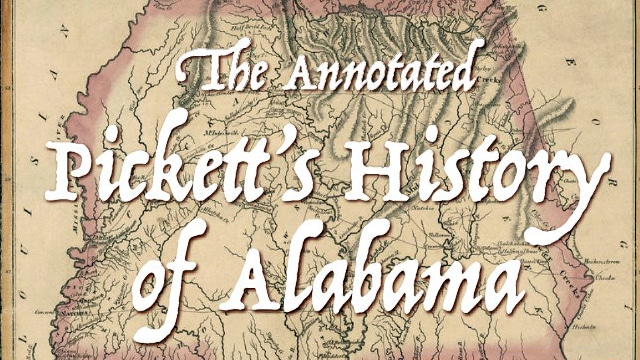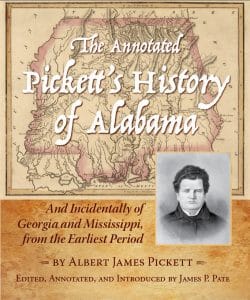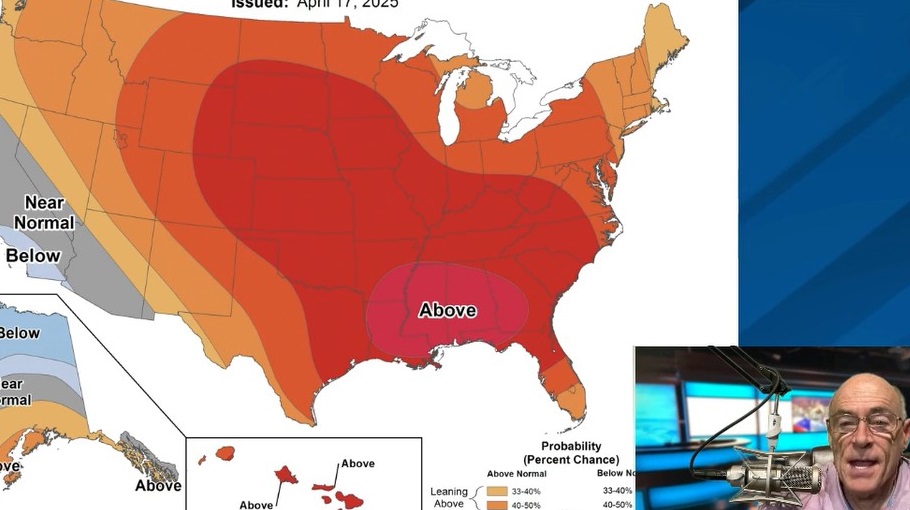‘Pickett’s History of Alabama’ to be re-released this month

(NewSouth Books)
The Spaniards were now in Alabama, in the territory embraced in the country of Cherokee, and by the side of the Coosa, one of our noblest streams. Never before had our soil been trodden by European feet! Never before had our natives beheld white faces, long beards, strange apparel, glittering armor, and, stranger than all, the singular animals bestrode by the dashing cavaliers! De Soto had discovered Alabama, not by sea, but after dangerous and difficult marches had penetrated her northeastern border with a splendid and well equipped land expedition! The Atlantic states were quietly discovered by voyagers entering their harbors. Alabama was marched upon by an army, whose soldiers sickened with famine upon the barrens of Georgia, and left tracks of blood upon the soil of Florida! …
On the 26th of July 1540, the army came in sight of the town of Coosa. Far in the outskirts, De Soto was met by the chief, seated upon a cushion, and riding in a chair supported upon the shoulders of four of his chief men. One thousand warriors, tall, active, sprightly and admirably proportioned, with large plumes of various colors on their heads, followed him, marching in regular order. His dress consisted of a splendid mantle of martin skins, thrown gracefully over his shoulder, while his head was adorned with a diadem of brilliant feathers. Around him many Indians raised their voices in song, and others made music upon flutes. The steel-clad warriors of Spain, with their glittering armor, scarcely equaled the magnificent display made by these natives of Alabama. – from “Pickett’s History of Alabama.”
Why “The Annotated Pickett’s History of Alabama” is the perfect book for the state’s bicentennial from Alabama NewsCenter on Vimeo.
“Pickett’s History of Alabama,” published in 1851, has been out of print for years. That will change on Oct. 15, thanks to Dr. Jim Pate and NewSouth Books.
“I first encountered Pickett’s book when I started teaching Alabama history at Livingston University (now the University of West Alabama),” said Pate, who is an emeritus professor of history at UWA, with 47 years experience in higher education. “I did a little research on Pickett, and also read sections that I thought were appropriate for my lectures on Alabama history.

Pickett’s History of Alabama.
“It is one of the primary studies of Alabama,” Pate continued. “Anyone, even today, writing about the state of Alabama, especially the colonial, territorial, or the protohistoric period – Pickett is a very, very critical source, which is not readily available.”
Given the importance of the work, Pate discussed with publishers the need to have the publication re-released, as early editions were too costly and facsimile copies were of poor quality. After nearly two decades of discussions and painstaking research, NewSouth Books decided to re-release the book in 2018, as part of the state’s bicentennial celebration.
“The annotation that I have added to this new edition provides a little more elucidation of what was going on and the sources that Pickett must have been using that he didn’t always cite,” Pate said. “Pickett was taking the reminiscences and memoirs of people, and sometimes inaccuracies creeped in – people’s memories were not as good or sharp as they might have been.
“Pickett really didn’t have the resources to check some of his sources to make sure that the dates he was using were the accurate dates, or even if the event occurred as it was described by the observers,” Pate continued. “One of the things that you discover in taking a person’s writing apart is the omissions or errors, and I’ve tried to provide a little more background, or correct those things.”
Albert James Pickett was born in Anson County, North Carolina in 1810, but at the age of 8, his family relocated to the “frontier” in Autauga County, Alabama. His father, William Pickett, operated a mill and trading house, and served in the Alabama House and Senate.
According to Pate, when Pickett was a young boy at his father’s trading house, he would listen to stories told by Creek Indians, Indian countrymen and revolutionary war heroes about the history and founding of Alabama.
“Growing up in that household and in that environment, Pickett learned so much about Alabama and the people who shaped it,” Pate said. “He was exposed to a very broad social, cultural milieu of Alabama.”
Pickett’s early education was in the local field schools, but he completed his higher education in Virginia. When he returned, he studied law under his brother, who was a judge in the Sixth Judicial Circuit. While Pickett never practiced law, “the law training he received under his brother and by visiting courts taught him document analysis – how to evaluate witnesses and stories,” Pate said. He used those skills in his early writing career for the newspaper in Montgomery.
Within a few years, Pickett received acclaim for articles and pamphlets he had written, so he decided to write the history of Alabama. “He spent the better part of four years doing research on his beloved Alabama,” Pate said.
During this time, there was no state archive or library, so Pickett had to obtain primary sources on his own. “He had to interview people who could tell him about the beginning of Alabama … and he purchased memoirs, letters and journals,” Pate said. “Pickett probably had one of the best libraries in central Alabama, and maybe one of the better libraries in all of Alabama.”
Pickett developed a series of questions that he asked each person he interviewed. “He really did a very modern kind of oral history interview, but most of them were through letters,” said Pate. These letters, known as the Pickett Papers, are preserved at the Alabama Department of Archives and History.
When the book debuted in 1851, “it was an overnight success and went through three editions” in its first year, Pate said. While Pickett had ambitions for other research and publications, he died in 1858.
Pickett has been called the “state’s first historian,” “the planter historian” and “Alabama’s commenter.” Now, thanks to Pate’s years of detailed research and annotation, this invaluable resource will be widely available to the public.
“I think that the annotated ‘Pickett’s History of Alabama’ is a publication that a lot of Alabamians would benefit from having in their home, and sharing with their children and grandchildren,” Pate said. “It was the first state history that was ever written, and it has some very succinct insights to native Alabamians.”
The new edition, which is fully indexed, carries an introduction by Pate, combines two volumes in one and is presented in readable wide format: Pickett’s original text and his own footnotes occupy the main part of the page, with Pate’s annotations in boldface in the margins.
“The Annotated Pickett’s History of Alabama” will be available Oct. 15 through your favorite local or online bookstore or from NewSouth Books at www.newsouthbooks.com.











